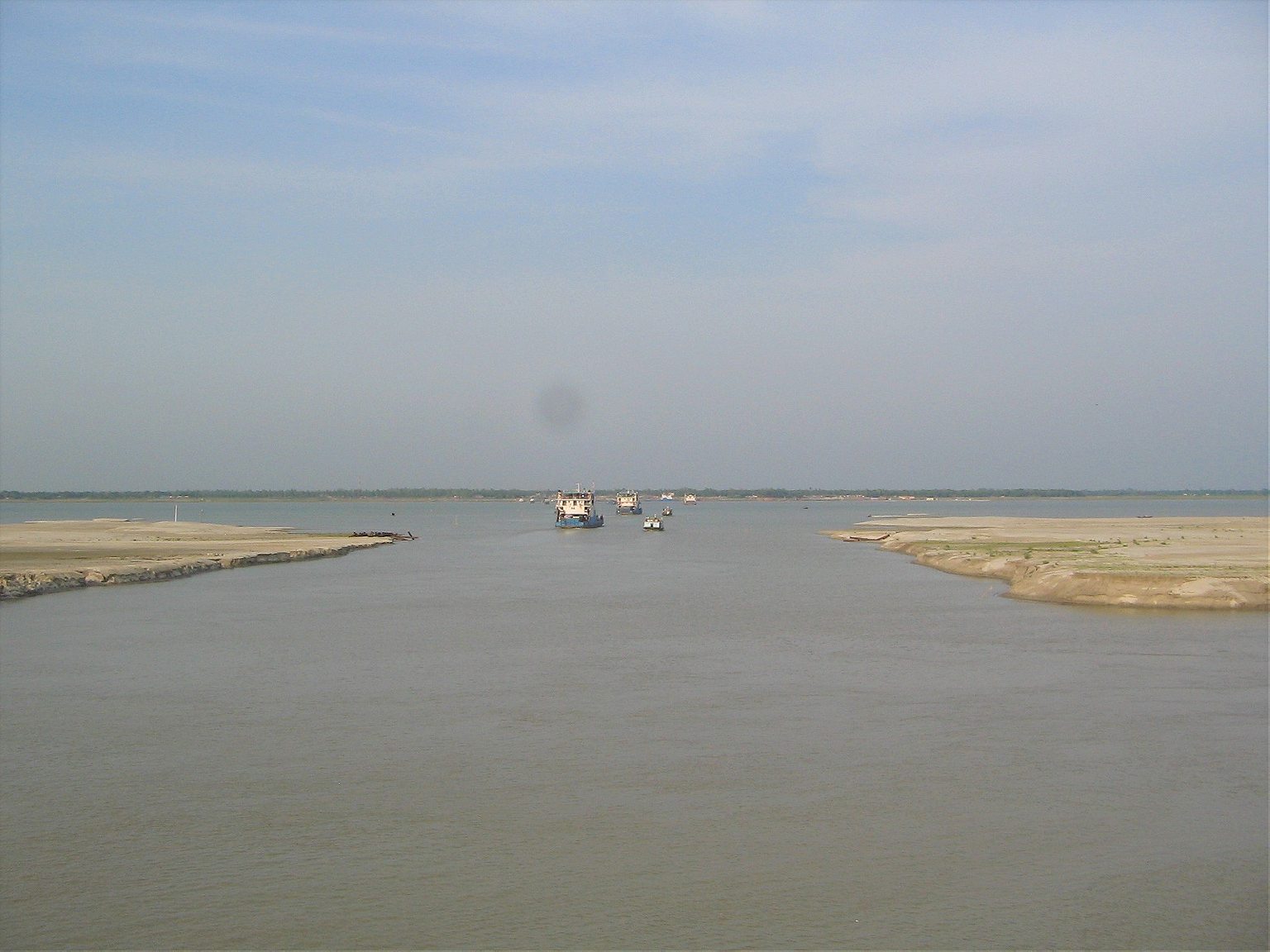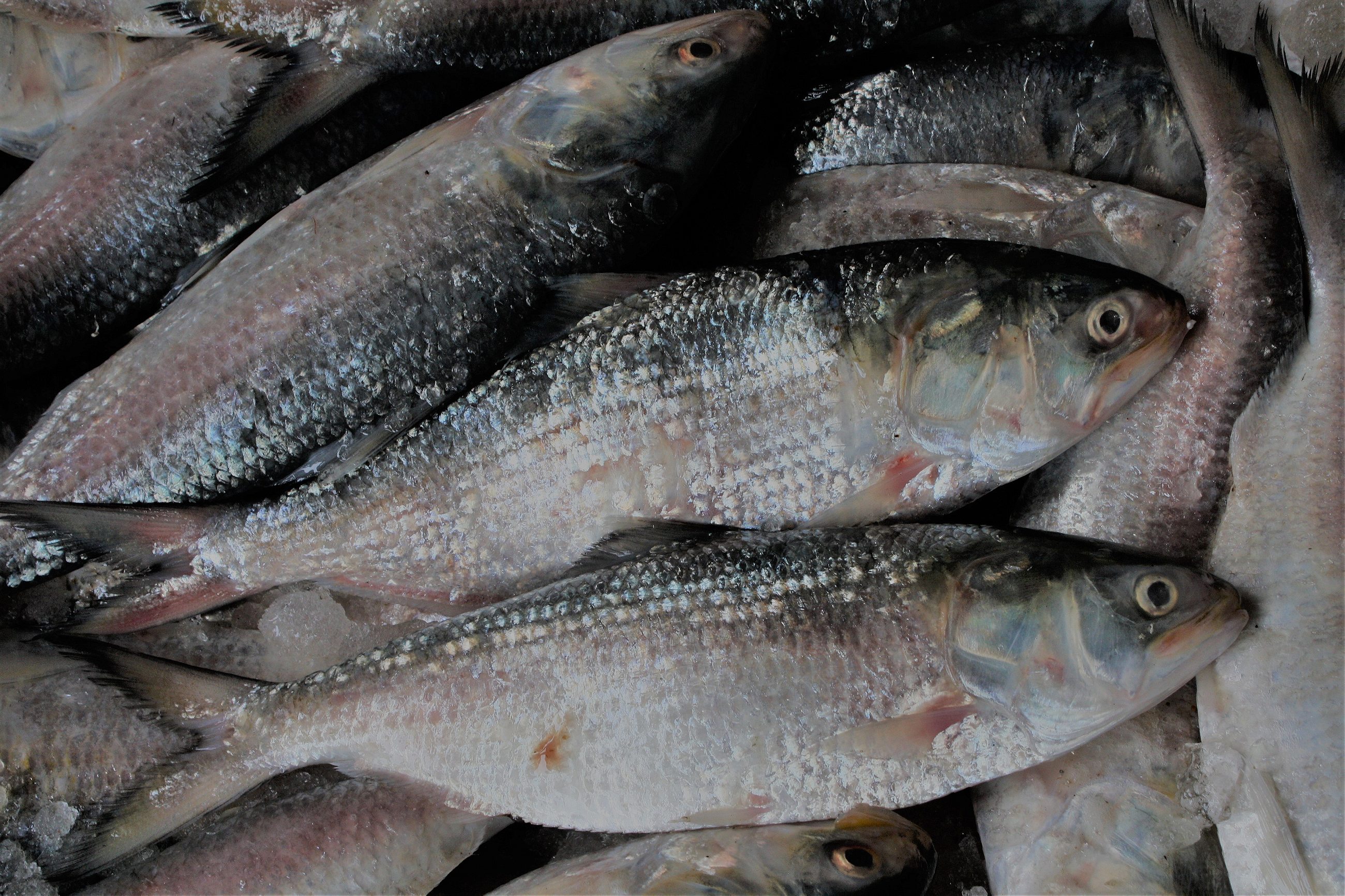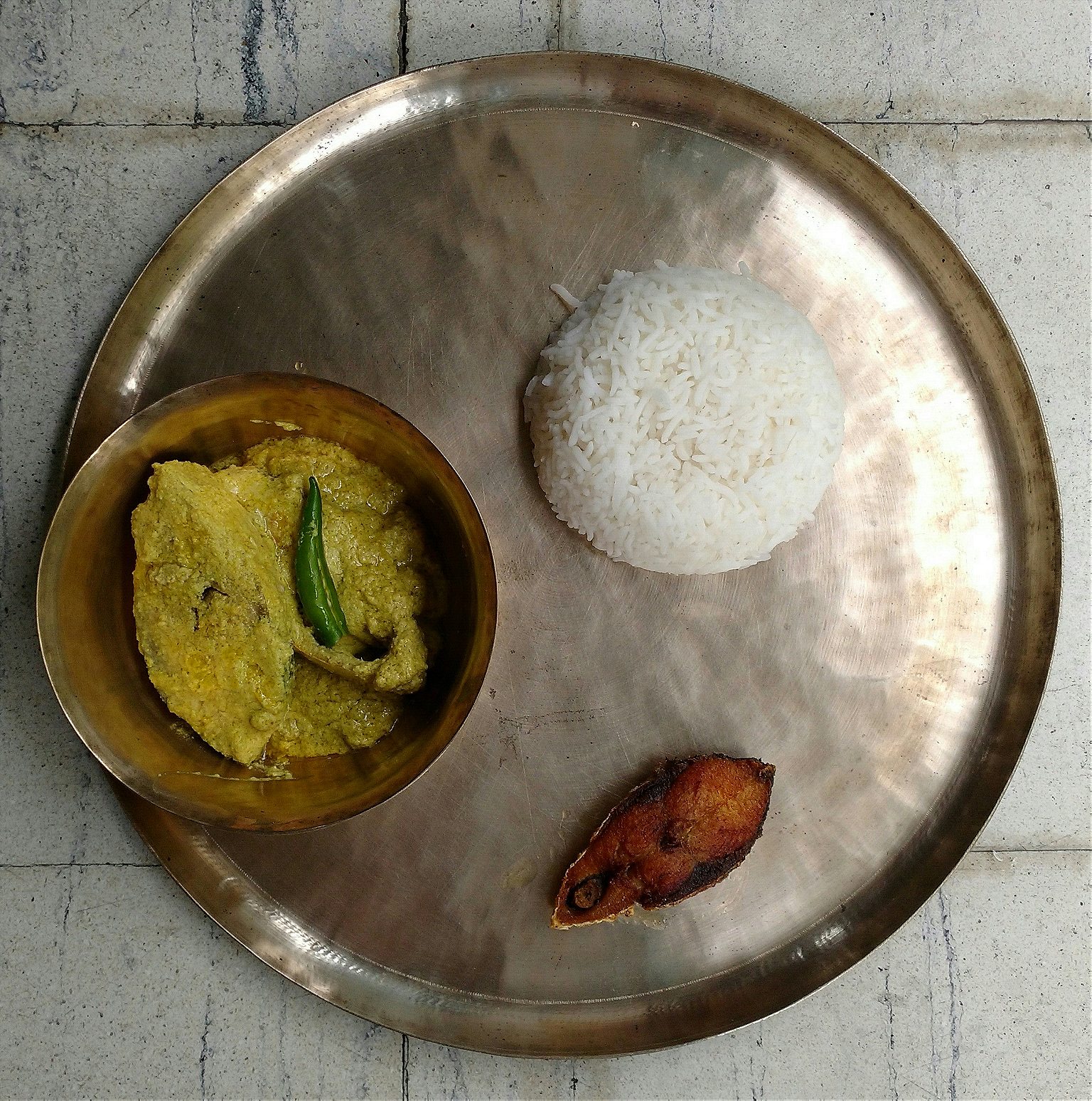For Bengalis living around the world, this fish is the taste of home.
WEST BENGAL, India—
Clouds rumbling in the sky; teeming rain.
I sit on the river bank, sad and alone.
The sheaves lie gathered, harvest has ended,
The river is swollen and fierce in its flow.
Poems have been composed, novels written, even films made about the Padma; Rabindranath Tagore, South Asia’s first Nobel Laureate, found solace and inspiration on its banks while living on his family’s estate at Shilaidaha in what is now Bangladesh, then still part of the colonial Indian state. My father, born not far from there in 1946, has never stopped talking about the river’s might. “You cannot see the other bank from one side,” he often says.
It’s odd that the Bengali bard would have brooded on the Padma’s sandy shore at that particular time of the year. Ordinarily, my father tells me, when rain clouds gather over the Padma, it’s a time to celebrate: it marks the season to eat ilish (hilsa in English), an indigenous variety of herring that is pretty much every Bengali’s favorite fish.
Hilsa appears at virtually every important occasion in Bengali life. In the past, the families of grooms presented hilsa, wrapped in a red sari and adorned with jewellery, to the bride’s family. During Jamai Shoshti, a holiday named for a Bengali benefactress of male children celebrated in May or June, mothers-in-law will buy hilsa at exorbitant prices and playfully bully their sons-in-law into feasting. During Saraswati puja, when the Hindu goddess of learning is worshipped in a series of elaborate rites at temporary temples erected around the city and in private homes, devotees traditionally present pairs of the fish to the deity as a sacred offering.
Like salmon, the hilsa lives in the sea and swims upstream to spawn, is beloved for the rich flavor and texture of its flesh, and, thanks to overfishing, is not-so-slowly disappearing from the seas. Unlike salmon, hilsa cannot be farmed, though many have tried. Though also found near the mouths of other sacred rivers, the Bengali hilsa is as tied to its habitat—the roiling Bay of Bengal, the tangled mangroves of the Sundarbans, and the slow-flowing waters of the Ganges-Brahmaputra Delta—as the people who consume it.

Until the Partition of India in 1947, modern-day Bangladesh and the Indian state of West Bengal were a single region called Bengal, famous for its love of culture, learning, sweets, and, of course, fish.
For much of the colonial period—from the arrival of the British East India company and well after the formation of the Raj—Bengal was the shining jewel in the crown of Anglo South Asia. The great port of Calcutta, near the mouth of the River Hooghly, one of the most important distributaries of the Ganges, was for centuries the largest city in South Asia and the capital of the British Empire. Even then, Bengalis were known for their special commitment to high culture (or, depending on whom you ask, for their snobbishness). The Bengali language even offers a word for long meandering talks that range widely over philosophy, music, poetry, and art: adda.
Bengalis under the Raj read and spoke clipped, precise English, sipped high tea at Victorian clubs, and spent evenings at operas and jazz clubs. The city began its decline in the 1920s, when the British decided to build a new imperial capital in Delhi. Following independence, the partition of Bengal separated Calcutta and Hindu-majority West Bengal from Muslim-majority East Bengal (later Bangladesh), as well as most of the linguistic region for which it served as the cultural, political, and economic capital.
Starting in the 1960s, the state of West Bengal, always a haven for progressive politics, came under the control of the Communist party, which brought high levels of literacy along with economic paralysis. Many Bengalis were forced to leave their homeland in search of better lives. This group of probashi (non-resident) Bengalis longed for their homeland: their music, literature, art, adda, and, of course, food.
When my father was a boy and Bengal had only recently been split in two, he and his father would travel to Calcutta from his hometown in Comilla. They would journey by train from there to Chandpur, then cross the Padma by steamboat and dock at Goalundo Ghat. Before boarding the train to Sealdah, one of the railheads in Calcutta, they would relish a lunch of rice and hilsa curry tempered with pungent, black nigella seeds.
“There was no other food available at the railway station. The locals would fish the hilsa right there and cook it fresh for the hungry passengers,” he remembers now. “I wonder if they used the river water to make the curry.”
Families divided by a carelessly drawn 20th-century border will argue endlessly over which side possesses the better fish.
It has been more than six decades, but the taste lingers. I grew up in Durgapur, a steel township 100 miles from Calcutta, but my childhood memories are laced with stories of East Bengal, which became East Pakistan after Partition, and Bangladesh in 1971 after a vicious war for independence. For years, my paternal grandmother would travel from Bangladesh to India to spend summer vacations with us. On dark nights when the power failed, she told stories of war and escape, of political turmoil and attacks by dacoits—or armed robbers—that haunted my brother and I for days. And she always brought us hilsa cured with salt, or nona ilish (nona means salty), made by salting and sun-drying the fish then preserving it in earthen pots to be savored throughout the year.
The eternal competition between east and west imposes itself everywhere in Bengali life, including on the beloved hilsa. Families divided by a carelessly drawn 20th-century border will argue endlessly over which side possesses the better variety. It begins with the all important question: “Was it caught in the Padma in Bangladesh, or the Ganga in India?” then swings toward differences in taste and texture, the heft and look of the fish pulled from different rivers, the recipes that define the cuisines of East and West Bengal.
Thoughtless borders and religious identities notwithstanding, Bengalis, as a whole, are obsessive fish-eaters. Look at a map and it’s not hard to see why. Innumerable rivers, small and large, cut through West Bengal and Bangladesh. This is where the Ganga—South Asia’s most sacred river—turns south and splits into the Padma, flowing across Bangladesh, and the Hooghly. From the east, the mighty Brahmaputra leaves the Himalayas and flows west across the Indian state of Assam, then turns ninety degrees to pour south through northern Bangladesh. The two great rivers meet in the world’s largest delta, subdividing endlessly among the mangrove forests of the Sundarbans, a major source of estuarine life, before emptying into the Bay of Bengal.

Fish—mostly freshwater—finds its way to the Bengali dining table daily, twice in many homes. Although the religiously conservative Brahmins in other communities are strictly vegetarian, many Bengali-Brahmins gladly devour fish (maach in Bengali) and meat. Everyday curries are usually simple, consisting of rohu, or freshwater carp, cooked with paanch phoron, literally “five spice,” a mixture of cumin, nigella, radhuni (or wild celery), fennel, and fenugreek; or in an onion-tomato-ginger curry flavoured with garam masala, the rich, endlessly variable blend of warm spices like cardamom, clove and cinnamon, that gives every region and home across India its individual scent.
I asked noted Bengali-American food historian and author Chitrita Banerji to explain the Bengali mania for hilsa. “I think its enduring role as an icon of Bengali food is a combination of many elements, not the least being its physical beauty, which has led Bengali writers to describe it as the darling of the waters or a prince among fish,” she says. “And its tender flesh (bony though it may be), combined with an emollient texture and exquisite flavor, lends itself to an infinite variety of culinary preparations.”
Coastal Indians often sneer at the hilsa’s countless needle-like bones and its exorbitant price (a two-pound fish can cost as much as $25), but to speak ill of the hilsa in front of a Bengali is blasphemy. It’s not just a fish, it’s an identity.
Preparation and consumption of hilsa is surrounded by ritual
Preparation and consumption of hilsa is surrounded by ritual. My mother, whose parents were originally from Dhaka–today the Bangladeshi capital and one of the densest, fastest-growing cities on earth–remembers watching her mother chop the head off the fish and then clean the body with water just once (purists claim that washing it any more than that will leach out its distinctive flavor).
For most of my school life, my mother strictly guarded my entry to the kitchen. On Christmas holidays, she’d let me in to watch her whip up sweets made from date palm jaggery, while in summers she’d allow me to help stack the kitchen shelves with mango pickles. In the monsoon, I’d catch her getting ready to cook ilish maach.
As I watched rain clouds gather sitting by the sooty kitchen window, she’d slice the fish with surgical precision on the boti, a traditional cutting utensil, essential to any Bengali kitchen, made from a long, upward-curving blade fixed to the end of wooden block. Once she’d broken down the fish into slices, she would wash the pieces and line them up neatly, sprinkling them with turmeric and salt to marinate. At the stove, with the loose end of her Bengal cotton sari tucked into her waist, Maa would gently pour dark yellow mustard oil into a wok, chop an eggplant length-wise, coat the slices with turmeric and salt, and, finally, when the oil was hot, slide them gently into the sizzling pan.
She would then remove the eggplant and flavor the same oil, glossy now with heat, with a sprinkling of fragrant black nigella seeds before sliding the pieces of fish in one by one, flipping them occasionally until they were cooked. As they neared completion, she added the fried eggplants, a pinch of turmeric and some water, then, finally, a slit green chili for heat before a final salt check. This simple jhol—or curry—was one of my favorite meals of the year.

Hilsa appears on the Bengali table in many different guises. There’s Bhapa ilish, steamed in a paste of mustard and poppy seeds, dried coconut, and green chillies. A few other recipes in Bangladesh call for a mixture of ginger, garlic, and onion, a preparation that would mortify any Indian-Bengali.
Other recipes, many of which I’ve never had a chance to try, have almost disappeared from modern kitchens. My mother has told me stories of hilsa cooked in a pulao—or pilaf (ilish pulao)—using fragrant, long-grained rice and garam masala. She told me of tangy curries infused with tamarind pulp (tetul ilish), and a version where the fish is fried with chopped onions, garlic, and green chillies until it turns crisp and starts to crumble (ilish jhuro).
But even as some dishes die away, the tradition of a long, leisurely lunch built entirely around hilsa remains. When a fish is plump with roe, we begin with egg sacks fried in mustard oil served with plain rice stained yellow by lashes of the bright yellow frying oil. Heads might appear next, cooked with eggplants, red pumpkin, bottle gourd, and potatoes or stir-fried with colocasia leaves (ilisher maatha diye chorchori). Last comes the rich mustard-based curry. A tidy line of bones around the edge of the plate is the sign of a good meal.

Hilsa today is in grave trouble. “Modern demands for eating hilsa throughout the year has led to a catastrophic reduction of the species,” says Banerji. “One could almost worry that some day this princely fish, with its burnished silver scales and eyes like blue gems, will not be dancing on the waters anymore.” Bengalis don’t reserve their poetry exclusively for rivers and clouds.
Last year, Bangladesh introduced a ban on catching juvenile or baby hilsa, imposing strict fines on anyone buying and selling specimens that weigh less than a pound. Today, fishermen on the Padma and Meghna rivers in Bangladesh are prohibited from venturing out during the breeding season and using fine-mesh nets that target juvenile fish. Across the border in West Bengal, the state legislature passed a similar law empowering the Fisheries Department to arrest and fine anyone caught with small fish.
But none of this has stopped illegal fishing. The average size of hilsa continues to shrink year on year. How much longer the fish can withstand our appetite—for its flesh and for the past—is unclear. But I continue to hope that one day I will cross the Padma on a steamboat in search of hilsa curry, just like my father.